Bill Maher recently interviewed Elon Musk. When Maher claimed that we are running out of water, Musk replied that “Earth is 70 percent water.” Maher shot back that “you can’t drink that.” Musk calmly replied that desalination is “absurdly cheap.”
How cheap is cheap? Energy Monitor notes that “globally, around 1% of the world’s drinking water is desalinated, but in Israel, that figure is around 25%.” Israel’s desalinated water comes from five desalination plants. The Sorek B plant has a capacity to desalinate 52.8 billion gallons a year and is contracted to produce water for $0.41 per cubic meter. There are around 264 gallons per cubic meter, so this puts the cost at about a penny per 6.4 gallons.
One hundred percent of the municipal water supply in the United Arab Emirates is desalinated. Dubai bloomed out of the desert with desalination technology. There are some 186 desalination facilities under construction or at the pre-construction phase around the world.
According to the website Filtration and Separation, in 2012, the cost to desalinate was $0.75 per cubic meter. In 2012, the average U.S. unskilled labor hourly wage was $10.87. In 2022, it had increased to $15.72. That puts the time price at about 4.14 minutes in 2012 and 1.56 minutes in 2022.
Put differently, in 2022 we were getting 165 percent more gallons of clean water for the same time price as was the case in 2012. Water abundance from desalination is growing at a 10.22 percent compound annual rate, doubling in abundance every seven years. These gains happened while we added 860 million people to the planet. Population was growing at a 1.14 percent annual rate, while desalination grew almost nine times faster.

We’re replacing salt with knowledge and turning a liability into an asset. Humans are exceptionally clever at innovating. Never underestimate our ability to adapt and thrive as long as we are free to discover valuable knowledge and share it with others in open markets.
This article was originally published at Gale Winds on 9/4/2023.

